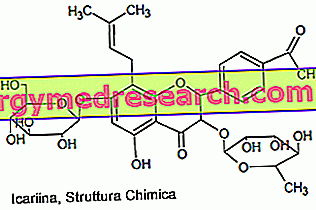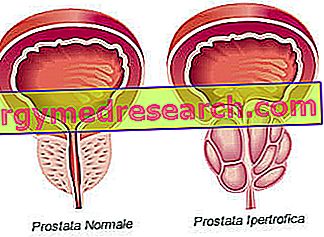Icariin is a flavonoid with structural formula C 33 H 40 O 15, contained in singular quantities in plants of the genus Epimedium . These plants, belonging to the Berberidaceae family, are widespread in the Asian territory, where for millennia they have been exploited in traditional Chinese medicine as a tonic and invigorating of sexual functions.

Experimental evidence
A careful research on the biological properties of Icariina shows over 200 articles in the literature, in which we tried to identify and characterize the mechanism of action of this substance, describing its different biological functions of considerable clinical impact.
Focusing only on the noteworthy studies, it would be possible to summarize the main biological activities of Icariina in:
- protective function against the genome, important in safeguarding cellular functionality (as demonstrated by evaluating the concentrations of carbonyl compounds derived from DNA oxidation), avoiding aberrant phenomena such as transformations and mutations;
- cytoprotective function, as observed with respect to membrane phospholipids and proteins subjected to oxidative stress, protected by the action of Icariin which guaranteed a significant reduction of markers of oxidative damage;
- vasoprotective function, observed against the endothelium subjected to damage from hydrogen peroxide. In these cases, Icariin has proved useful in promoting the elimination of damaged endothelial cells, preserving the vessel from the classic atheromatous degeneration associated with significant endothelial damage;
- neuroprotective function, observed in experimental animal models of Alzheimer, therefore subjected to the action damaging to beta amyloid. These studies show that Icariin protects the central nervous system from classical degeneration, through a series of multiple mechanisms, guaranteeing a protective action against the gradual cognitive decline that characterizes these eventualities;
- osteoprotective function, documented by several studies and most likely associated with an intracellular action. Icariin, in fact, seems to promote the expression of genes involved in osteoblastic differentiation and activation, instead inhibiting the activation of genes such as NfKB or RANK L, involved in osteoclast-mediated bone resorption processes;
- immunoprotective function, important in eliminating the immune system, exerting an immunoadjuvant function comparable to that of cytokines, such as IL 2.
Clinical evidence
In the light of the many and encouraging experimental evidences, we would expect a refined scientific literature on the clinical use of Epimedium .
Unfortunately, the evidence in this sense is decidedly disappointing, with limited clinically significant studies, despite the enormous potential of the active principle.
However from these few data the osteoprotective role of Icariin emerges, as demonstrated in post-menopausal women in whom the integration with 60 mg id Icarina plus other flavonoids and calcium, has proved useful in preventing bone demineralization without any effect collateral at the endometrial level, in terms of hyperplasia.
The bibliography on the use of Icariin as a natural aphrodisiac is also disappointing, although there are some experimental studies that show how the vasoprotective and neuroprotective action of this compound can be effective in improving the sexual abilities of rats suffering from erectile dysfunction.
Considerations
Although the experimental studies are quite promising, the absence of clinical trials does not allow an accurate assessment of the real potential of this active principle, and above all it does not allow the identification of standardized dosages that can be proposed in clinical practice.
The same situation makes it difficult to identify the contraindications and the related risks related to the use of this substance, thus leaving the last word always to the doctor responsible for the clinical situation of his patient.
In view of the considerable potential of Icariina, it would therefore be desirable to promote a progression of clinical studies, so that an active ingredient so potentially useful can find its worthy space in the panorama of natural supplements and herbal medicines.
Bibliography
Potent inhibition of human phosphodiesterase-5 by icariin derivatives.
Dell'Agli M, Galli GV, Dal Cero E, Belluti F, Matera R, Zironi E, Pagliuca G, Bosisio E.
J Nat Prod. 2008 Sep; 71 (9): 1513-7. doi: 10.1021 / np800049y. Epub 2008 Sep 9.
Icariin delays homocysteine-induced endothelial cellular senescence involving activation of the PI3K / AKT-eNOS signaling pathway.
Xiao-Hong D, Chang-Qin X, Jian-Hua H, Wen-Jiang Z, Bing S.
Pharm Biol. 2013 Apr; 51 (4): 433-40. doi: 10.3109 / 13880209.2012.738332. Epub 2013 Jan 22.
Icariin associated with exercise therapy is an effective treatment for postmenopausal osteoporosis.
Liu M, Zhong C, He RX, Chen LF.
Chin Med J (Engl). 2012 May; 125 (10): 1784-9.
The dose-effect of icariin on the proliferation and osteogenic differentiation of human bone mesenchymal stem cells.
Fan JJ, Cao LG, Wu T, Wang DX, Jin D, Jiang S, Zhang ZY, Bi L, Pei GX.
Molecules. 2011 Dec 6; 16 (12): 10123-33. doi: 10.3390 / molecules161210123.
[Progress of pharmacological research on icariin].
Li L, Wang XM.
Zhongguo Zhong Yao Za Zhi. 2008 Dec; 33 (23): 2727-32. Review. Chinese.
Epimedium-derived phytoestrogen flavonoids exert beneficial effect on preventing bone loss in late postmenopausal women: a 24-month randomized, double-blind and placebo-controlled trial.
Zhang G, Qin L, Shi Y.
J Bone Miner Res. 2007 Jul; 22 (7): 1072-9.
Icariin enhances endothelial nitric-oxide synthase expression on human endothelial cells in vitro.
Xu HB, Huang ZQ.
Vascul Pharmacol. 2007 Jul; 47 (1): 18-24. Epub 2007 Mar 24.
Effect of icariin on hypoxia induced vascular endothelial cells injury].
Ji RR, Li FY, Zhang XJ.
Zhongguo Zhong Xi Yi Jie He Za Zhi. 2005 Jun; 25 (6): 525-30. Chinese.
The antioxidative effect of icariin in human erythrocytes against free-radical-induced haemolysis.
Liu ZQ, Luo XY, Sun YX, Wu W, Liu CM, Liu ZQ, Liu SY.
J Pharm Pharmacol. 2004 Dec; 56 (12): 1557-62.
[Experimental studies of icariin on anticancer mechanism].
Mao H, Zhang L, Wang Y, Li X.
Zhong Yao Cai. 2000 Sep; 23 (9): 554-6. Chinese.
Immunoregulatory effects of the herba Epimediia glycoside icariin.
He W, Sun H, Yang B, Zhang D, Kabelitz D.
Arzneimittelforschung. 1995 Aug; 45 (8): 910-3.
[Effects of icariin on beta-amyloid and neurotrophic factors in the brain of mitochondrial deficiency model rats].
Zhang RY, Zhang L, Ai HX, Zhang L, Li L.
Zhongguo Zhong Yao Za Zhi. 2013 May; 38 (9): 1285-9. Chinese.
[Effect of icariin on learning and memory abilities and activity of cholinergic system of senescence-accelerated mice SAMP10].
Gao L, Tang Q, He X, Bi M.
Zhongguo Zhong Yao Za Zhi. 2012 Jul; 37 (14): 2117-21. Chinese.
Epimedium koreanum Extract and Its Constituent Icariin Improve Motor Dysfunction in Spinal Cord Injury.
Tohda C, Nagata A.
Evid Based Complement Alternat Med. 2012; 2012: 731208. doi: 10.1155 / 2012/731208. Epub 2012 Aug 23.



